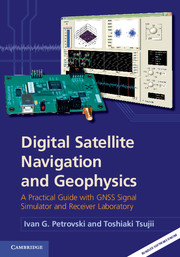 Digital Satellite Navigation and Geophysics
Digital Satellite Navigation and Geophysics Book contents
- Frontmatter
- Contents
- Foreword
- Preface
- 1 Methods of positioning with navigation satellites
- 2 Presentations and applications of GNSS orbits
- 3 GNSS signal generation in transmitters and simulators
- 4 Signal propagation throughthe atmosphere
- 5 Receiver RF front end
- 6 Real-time baseband processor on a PC
- 7 Multipath
- 8 Optimization of GNSS observables
- 9 Using observables in navigation-related tasks
- 10 Electromagnetic scintillation of GNSS signal
- 11 Geophysical measurements using GNSS signals
- 12 Aiding baseband and navigation processors using INS
- Next step – RF lab
- Index
- References
10 - Electromagnetic scintillation of GNSS signal
Published online by Cambridge University Press: 05 March 2012
- Frontmatter
- Contents
- Foreword
- Preface
- 1 Methods of positioning with navigation satellites
- 2 Presentations and applications of GNSS orbits
- 3 GNSS signal generation in transmitters and simulators
- 4 Signal propagation throughthe atmosphere
- 5 Receiver RF front end
- 6 Real-time baseband processor on a PC
- 7 Multipath
- 8 Optimization of GNSS observables
- 9 Using observables in navigation-related tasks
- 10 Electromagnetic scintillation of GNSS signal
- 11 Geophysical measurements using GNSS signals
- 12 Aiding baseband and navigation processors using INS
- Next step – RF lab
- Index
- References
Summary
“Long Telescopes may cause Objects to appear brighter and larger than short ones can do, but they cannot be so formed as to take away that confusion of the Rays which arises from the Tremors of the Atmosphere. The only remedy is a most serene and quiet Air, such as may perhaps be found on the tops of the highest mountains above the grosser Clouds.”
Sir Isaac Newton, Opticks (1730).An effect of electromagnetic scintillation has been noted in the visible frequency range with the introduction of telescopes. It is a random rapid fluctuation of signal instant amplitude and phase. Newton identified this phenomenon with the atmosphere and recommended locating telescopes on the tops of the highest mountains. Further advance in scintillation research was achieved when astronomy moved to radio frequencies. Scintillation effects had been discovered by monitoring signals from other galaxies, in particular from Cassiopeia [1]. The source of scintillation had been established by making measurements with a set of receivers located at a distance from each other and operating on various frequencies. Correlations between scintillation effects in the receivers at different locations established that the source of scintillation is in the Earth’s atmosphere. The dependence on frequency showed that the medium in which scintillation occurs is dispersive.
A GNSS signal in particular is subject to amplitude and phase scintillation caused by its propagation through the atmosphere, though the scintillation effects on GNSS from signal propagation in the troposphere are much smaller than those caused by signal propagation in the ionosphere. The effect of signal scintillation is important for navigation and geodetic applications, because it affects receiver performance to a point where it may lose a lock and stop tracking a signal. Amplitude scintillation results in signal quality degradation. Phase scintillation affects the carrier tracking loop in such a way that it requires a wider bandwidth due to higher dynamics of the carrier. In Chapter 12 we consider such effects and how they can be mitigated for some applications.
Information
- Type
- Chapter
- Information
- Digital Satellite Navigation and GeophysicsA Practical Guide with GNSS Signal Simulator and Receiver Laboratory, pp. 241 - 269Publisher: Cambridge University PressPrint publication year: 2012